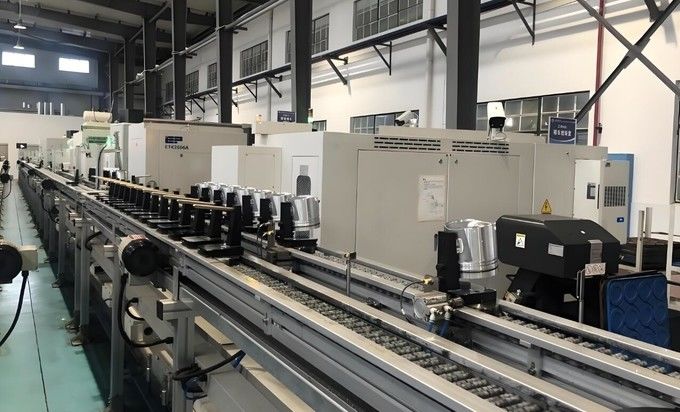Aluminium Alloy Diesel Engine Piston
The aluminium alloy is formed into roughly shaped piston body by die casting process.
1, Foundry Process: At the foundry, die is prepared for taking molten aluminium alloy by heating it to operating temperature for approximately one hour. This process allows the die to readily accept the molten material when it is poured. The process starts by heating the aluminium alloy well above the melting point but below its boiling point, i.e, up to 700°C. Molten aluminium alloy is then poured into the die through sprue. Thematerial is then allowed to cool into the die for solidification, followed by placing it into a bin of hot water. After appropriate cooling the sprue section of casting is cut by a band saw, which is then resent for melting in furnace, while piston body is sent for further machining.
2, Pin Boring Process : At this stage, the piston casting has the gudgeon pin hole rough machined by a boring machine.
3, Turning Process: Turning of the piston casting is carried out on precision lathe machines. The castings are placed in the lathe and held in place by a solid rod through the gudgeon pin hole. A draw bolt is activated in the
chuck which draws the rod towards chuck and holds the piston in place during its machining. The piston is now ready for finishing processes.
4, Drilling Process: The process includes drilling of oil holes in gudgeon pin bosses and oil ring grooves, cutting slots in the skirt, valve relieving and crank relieving.
5, Washing Process: To ensure that excess particles caused by machining procedures are removed from the piston, in a special temperature, high precision washing using ultrasonic and spray systems and detergents is carried out.
6, Finishing Process
6.1, Grinding Process: This process involves the final size being machined on the piston. The process involved is cam grinding which machines the skirt of the piston only.
6.2, Reaming Process: This is the final machining process which involves the piston being placed in a bath of oil and reamed to reach the final size required.
7, Phosphating Process: In this phase, pistons are prepared for coating.
Coating & Covering Process: Coverage of tin and graphite decreases friction and improves corrosion and wear resistance. This will stop engine from having a piston failure in critical conditions. In the last phase of production, various petrol and diesel engine pistons are covered with tin and graphite using spray or Silkscreen method.
8, Final Inspection: At this stage, the piston is cleaned, then size and category are stamped and then sent for dispatch
Diesel Engine Piston Workshop


Piston Testing Equipment




Other Equipment






Research & Development
Bolante Machinery is a professional supplier in the heavy duty machinery industry with over 20 years of design and manufacturing experience. We can provide global customers with custom design, R&D, and manufacturing service for the products we focus on, and we have a perfect after-sales system.
We design and develop diesel engine parts for a wide range of industries. Cooperation with excellent customers has kept our technology in continuous progress, and the automation level are constantly optimized and updated, helping customers improve production efficiency and product quality.
We have a professional technical team, including mechanical engineers, mold engineers, and other professional technicians with rich experience. We rely on the progress of technology and the accumulation of experience, and constantly innovate and develop to provide quality products and services for our customers worldwide.
Centrifugal Casting Material Development
1, With more than 10 series of 25 kinds of materials,include matrix structures of bainite, pearlite, austenite, martensite, ferrolites
2, Mature nodular cast iron and Compacted graphite iron castings Production process
3, Tin bronze, aluminum brass and other copper alloy materials
4, Chromium Alloy Anti-wear iron
High Level & Efficienty Honing Tech
1, Plateau Honing
2, Spiral Sliding Honing
3, Laser Honing
4, Brush Honing
5, Lapping Honing
Surface Treatment Tech
1, Phosphating
2, Ion Nitriding
3, Gas Nitriding
4, Salt Bath Nitriding
5, Isothermal Quenching
6, Vacuum Hardening
7, High Frequency Hardening
8, Tempering
9, Normalizing
10, Annealing, etc.
These surface treatment process can effectively improve the capacity of anti-cavitation and anti corrosion, and reduce the frictional work.
Strengthening
Shot peening and rolling can increase the cylinder liner minimum breaking load,improving the ability of anti fatigue-fracture.

 Your message must be between 20-3,000 characters!
Your message must be between 20-3,000 characters! Please check your E-mail!
Please check your E-mail!  Your message must be between 20-3,000 characters!
Your message must be between 20-3,000 characters! Please check your E-mail!
Please check your E-mail! 

